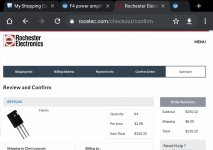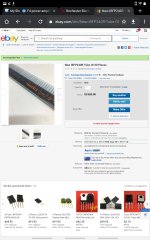Devices like that are always useful to have.
Given you have 0.47 Ohm source resistors, that kind of matching is probably ok.
I tend to use that kind of thing to determine Vgs threshold at say 2.5mA and sort them accordingly, I then select from those matched parts and measure at operating conditions on a heatsink to finally choose my parts, but I don't use source resistors, so it's more critical for me.
Given you have 0.47 Ohm source resistors, that kind of matching is probably ok.
I tend to use that kind of thing to determine Vgs threshold at say 2.5mA and sort them accordingly, I then select from those matched parts and measure at operating conditions on a heatsink to finally choose my parts, but I don't use source resistors, so it's more critical for me.
Last edited:
Given that the power supply is capable of the 22v & .4A that's in the f4 spec, can I just insert the appropriate resistor, attach a heat sink, and let them heat up for a more accurate measurement?
Thanks for the input...
Thanks for the input...
When you match larger batches you can get way closer sets. I’ve matched sets of 32 within 10 mv using a 500 part batch
Yes you can do that.
You have to have some way of setting Vgs to an appropriate level eg trimpot, or current limit the device, etc.
You have to have some way of setting Vgs to an appropriate level eg trimpot, or current limit the device, etc.
Whatever I do, I need it to be an easy enough build that my dumb adult-lego *** can do it, and have the results be good enough that others will want to take the parts for their builds... hording 100 mosfets isn't going to serve me any purpose.
And was going to use this (12-32v) adjustable power supply to set Vgs... Amazon.com: Gowoops 2PCS 150W DC-DC 10-32V to 12-35V Step Up Boost Converter Module Adjustable Power Voltage: Electronics
And was going to use this (12-32v) adjustable power supply to set Vgs... Amazon.com: Gowoops 2PCS 150W DC-DC 10-32V to 12-35V Step Up Boost Converter Module Adjustable Power Voltage: Electronics
Let's say you settle on 20V Vds (close enough)
You could run a 30k resistor in series with a 10k trim pot. Wiper connected to the gate of the mosfet.
So it's +20V - 30k resistor - 10k Trim Pot - Ground
With this method you can measure current with varying changes in Vgs. Vgs max setting will be 5V
Alternatively you could make a ccs with a bipolar and resistor connected to the mosfet and measure Vgs at a constant current.
Both are easy to make.
Depends which approach you prefer.
You could run a 30k resistor in series with a 10k trim pot. Wiper connected to the gate of the mosfet.
So it's +20V - 30k resistor - 10k Trim Pot - Ground
With this method you can measure current with varying changes in Vgs. Vgs max setting will be 5V
Alternatively you could make a ccs with a bipolar and resistor connected to the mosfet and measure Vgs at a constant current.
Both are easy to make.
Depends which approach you prefer.
Ok, I did it. Thanks for the suggestion Nelson and the push Jim. I guess I will have to learn something new while making a new set of premium f4 boards after all. Also picked up a tube of 30 Harris irf240Rs off of eBay: New IRFP240R Tube Of 30 Pieces | eBay
I didn't want to mention it so as not to get accused of wasting money, but I'm also using premium resistors throughout the build.
After trying a variety of amplifiers over the past two years (Lyngdorf tdai-3400, Coincident Frankenstein 300b monos, atma-sphere M60 monoblocks, Pass xa-25, & ZM sissy-sit), I've found the F4s to be the best match to my system (A WIP System: Work In Progress (Denver, CO) - Virtual Systems). A month ago I built upgraded power supplies in their own chassis to great effect and now am doing the premium boards with naked z-foils in the signal path. I was looking forward to some A/B testing to see if they mattered, but I guess the mosfet change will ruin that comparison. Gonna quit thinking about amplifiers after that and see if I can build a DHT preamp to try out.
If anyone wants some matched Harris 9240s, let me know. I'll have 72 extra. I start a new job/career in another month or so and thought this would be a fun way to end unemployed quarantine.
Such a good group over here, thanks for all the help. I'm sure I'll be asking for more.
Attachments
I just purchased some Harris IRFP9140
I am curious to see how it compares to my other versions of this amp.
I am curious to see how it compares to my other versions of this amp.
Ok, I did it ...
If anyone wants some matched Harris 9240s, let me know. I'll have 72 extra. I start a new job/career in another month or so and thought this would be a fun way to end unemployed quarantine.
Hah! Good for you. I've got an F4 ready to go into the chassis, but Nelson's Harris reference go me fired up, too. I'd be thrilled to take some matched pieces of your pie, and then not be kicking my own self for not plunging into the project by buying 84 of 'em.
Great. I've got two on the list. Can you send me a pm with desired quantity just so that I don't lose track?
Also, since I am in the enviable position of being unemployed, but with a full salary coming shortly, I went ahead and purchased a fully regulated lab bench supply and am getting a pid controller with heating and cooling elements so I can test the 9240s at 22v, .4a, & at operating temperature.. just like they'll be run in the f4. In for a penny, in for a pound (and recently single and incredibly bored).
Also, since I am in the enviable position of being unemployed, but with a full salary coming shortly, I went ahead and purchased a fully regulated lab bench supply and am getting a pid controller with heating and cooling elements so I can test the 9240s at 22v, .4a, & at operating temperature.. just like they'll be run in the f4. In for a penny, in for a pound (and recently single and incredibly bored).
Got my mosfets, but still waiting on testing parts.
A quick question while thinking about matching.
So we can pull the .47ohm resistors if the mosfets are matched?
How closely matched do I need to be?
A quick question while thinking about matching.
So we can pull the .47ohm resistors if the mosfets are matched?
How closely matched do I need to be?
If you match at a constant current of say 0.5 A then matching to better than 20mV would be probably ok.
Either way write down the values you get and obviously choose the best matching devices, if you can get better than 10mV then go with those.
I think I wrote down what I was able to get, somewhere.
Either way write down the values you get and obviously choose the best matching devices, if you can get better than 10mV then go with those.
I think I wrote down what I was able to get, somewhere.
Last edited:
The source resistors act as a kind of local feedback and help linearize the operation. I wouldn’t remove them, though if you had really tight matches you might try making the value smaller. It’s only half an ohm stock, however...
There are multiple parameters that define the currentsharing through the various Parallel fets. One is the Ugs at a given current and another is the Gm (Amp/V)
Matching typically only adresses matching of Ugs but not the Gm. Using the resistor will provide improved currentsharing eve n when Ugs is matched as when the amp is in use, the current will change (signal!)
Matching typically only adresses matching of Ugs but not the Gm. Using the resistor will provide improved currentsharing eve n when Ugs is matched as when the amp is in use, the current will change (signal!)
What about the resistors on the input jfets? I saw ZM recommend removing them in the case of right tight matching as well.
And thanks for all the input, just trying to learn about what all these parts do and how to maximize the circuit. Still very dumb about it all...
And thanks for all the input, just trying to learn about what all these parts do and how to maximize the circuit. Still very dumb about it all...
Also, 30 Harris irfp2940s taken, 54 left... PM me if you want to get on board. Probably two weeks out from packaging, assuming I don't encounter any unexpectancies when building my temperature controlled test bed.
I would suggest matching them for Vgs threshold and at least 2 other bias points.
I generally do full curves of Id vs Vgs, if you can do that, then also do that.
Select your best parts.
Start with 0.1 source resistors check the current sharing under those conditions.
If the sharing is say less than 10mA different between devices then take out the source resistors.
If I can do this then obviously other people are capable, surely I am not the only one that is still a member of the FAB club.
I generally do full curves of Id vs Vgs, if you can do that, then also do that.
Select your best parts.
Start with 0.1 source resistors check the current sharing under those conditions.
If the sharing is say less than 10mA different between devices then take out the source resistors.
If I can do this then obviously other people are capable, surely I am not the only one that is still a member of the FAB club.
Last edited:
- Home
- Amplifiers
- Pass Labs
- F4 power amplifier

